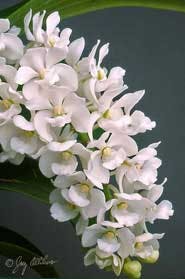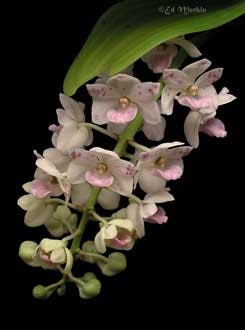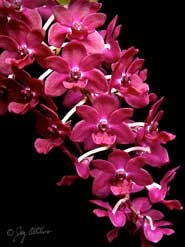Rhynchostylis gigantea (Lindl.) Ridl.

A fine example of the typical spotted form of Rhy. gigantea.
Rhynchostylis gigantea has definitely become a collector's item in recent years with ever more unusual color forms being introduced into the marketplace. The unmistakeable spicy fragrance is consistent across this genus, whether the species blooms in the winter or summer. One species, Rhy. retusa, is referred to as the "fox tail" orchid because of its long tapering inflorescence. The inflorescence of Rhynchostylis gigantea is somewhat shorter, the actual length being determined by genetics and culture of the individual plant. There is something exotic and magical about walking into a winter greenhouse and encountering the warm fragrance of Rhy. gigantea. It leaves a lasting impression one looks forward to year after year.

Pure white forms of Rhy. gigantea have been awarded as both var. alba, and var. petotiana.
This orchid prefers the warm humid climate of Southeast Asia and ranges from Hainan, China through Myanmar, Laos, Thailand, Viet Nam, Malaysia and into the Philippines. Rhy. gigantea was discovered in Burma (Myanmar) by Wallich and described as Saccolabium giganteum by Lindley in 1833. Ridley transferred it to Rhynchostylis in 1896 (J. Linn. Soc., Bot. 32: 356). Over the years there have been numerous varietal names applied to different color forms but they are all of horticultural use only. At this time, the Kew Monocot Checklist recognizes only two subspecies with Rhynchostylis gigantea subsp. violacea (Lindl.) Christenson, being endemic to the Philippines.

A beautiful pink form grown and photographed by Ed Merkle.
Although this is indeed a warm-growing orchid, it is tolerant of a wider range of light conditions than other Vandaceous orchids making it more acessible to hobbyists. We like to grow it less bright than our vandas and ascocendas...about 2000-2500 foot candles is a good range if you are measuring. I have also seen some people growing Rhy. gigantea under lower light like a Phalaenopsis. The leaves will be a dark green but it does not seem to dimnish flower production. Most growers in warm climates grow the species in empty teak baskets although some will put a few large chunks of charcoal to help anchor the plant. One grower I knew of years ago used weathered beef bones in a basket with his Rhynchostylis saying that they liked the calcium. This is an adaptable orchid however, and those living in drier temperate climates might do well using a large plastic pot with coarse bark mix. That being said, I recently saw two awarded Rhy. gigantea at a Florida orchid show that were being grown in large plastic pots of a peat-based "mud mix" that is usually used for Phalaenopsis. One main consideration with Rhy. gigantea is repotting, which can be challenging because of the very stiff, thick roots. Soaking them helps a little, but whatever potting approach you settle on should be chosen with longevity in mind.

This dark wine-colored form of Rhy. gigantea has variously been known as var. rattana, or "Sagarik Strain".
That is why a wooden basket is popular because it is limited only by the life of the wood. The culture regimen fits within that of your other orchids; fertilize once a week during warm months and every other week in winter. You will need to adapt watering practice based upon potting. These orchids appreciate frequent watering but do not like to stay wet.
Rhynchostylis gigantea blooms in January-February. Choose blooming plants now at your nearest local orchid show.

This peach-colored form is occasionally called Rhynchostylis gigantea var. vivaphandhul.








